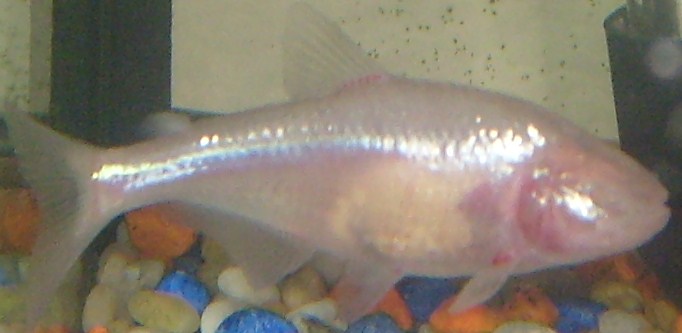Astyanax mexicanus
Enlarge text Shrink textThe Mexican tetra (Astyanax mexicanus), also known as the blind cave fish, blind cave characin or the blind cave tetra, is a freshwater fish in the Characidae family (tetras and relatives) of the order Characiformes. The type species of its genus, it is native to the Nearctic realm, originating in the lower Rio Grande, and the Neueces and Pecos Rivers in Texas, into the Central Plateau and eastern states of Mexico. Maturing at a total length of about 12 cm (4.7 in), the Mexican tetra is of typical characin form, albeit with silvery, unremarkable scalation, likely an evolutionary adaptation to its natural environment. By comparison, the species' blind "cave" form has scales which evolved a pale, pinkish-white color, somewhat resembling an albino, as it inhabits pitch-black caverns and subterranean streams and has no need for a colorful appearance (i.e. for attracting mates). Likewise, the blind cave tetra has fully "devolved" (lost) the use of its eyes by living in an environment completely devoid of natural light, with only empty sockets in their place. The blind tetra instead has sensory organs along its body, as well as a heightened nervous system (and senses of smell and touch), and can immediately detect where objects or other animals are located by slight changes in the surrounding water pressure, a process vaguely similar to echolocation—another adaptation known from cave-dwelling, as well as aquatic, species, such as the bats and cetaceans. The Mexican tetra's blind variant has experienced a steady surge in popularity among modern aquarists. A. mexicanus is a peaceful, sociable schooling species, like most tetras, that spends most of its time in midlevel waters above the rocky and sandy bottoms of pools, and backwaters of creeks and streams. Coming from an environment somewhere between subtropical climate, it prefers water with 6.5–8 pH, a hardness of up to 30 dGH, and a temperature range of 20 to 25 °C (68 to 77 °F). In the winter, some populations migrate to warmer waters. The species' natural diet consists largely of crustaceans, annelids and arthropods and their larvae, including both aquatic insects, such as water beetles, and those that land on or fall in the water, like flies or arachnids. It will also supplement its diet with algae or aquatic vegetation; in captivity, it is largely omnivorous, often doing well on a variety of foods such as frozen/thawed or live cultured blackworms, bloodworms, brine shrimp, daphnia, and mysis shrimp, among other commercially available fish foods. The Mexican tetra has been treated as a subspecies of A. fasciatus, though this is not widely accepted. Additionally, the hypogean blind cave form is sometimes recognized as a separate species, A. jordani, but this directly contradicts the phylogenetic evidence.
Read more on Wikipedia >
 Topic
Topic




